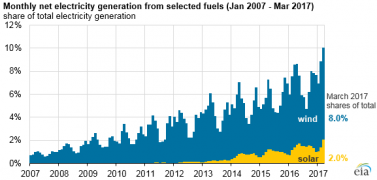For March and April (May data isn’t in yet), wind and solar provided over 10% of US electricity – a first!
In 2016, wind and solar supplied 8% of US electricity, so you can see it’s edging up. Wind supplies 6% and solar, 2% of electricity, according to the US Energy Information Agency (EIA). Another 4% comes from energy storage, including pumped hydroelectric, batteries and flywheels.
In the first quarter of 2017, the wind industry added 2 gigawatts – which means a turbine is installed every 2.5 hours! “We switched on more megawatts in the first quarter than in the first three quarters of last year combined,” says Tom Kiernan, CEO of the American Wind Energy Association (AWEA).
When Congress extended tax credits for wind and solar in 2015, they set them to gradually phase out by 2020, incentivizing a boom until then.

First Energy Storage Mandates
To boost wind and solar production, California is the first state to mandate energy storage. A law passed In 2013 requires utilities to buy 1.3 gigawatts of energy storage by 2020 and utilities will also distribute $450 million in incentives for homeowners and businesses to buy their own storage solutions.
Massachusetts is setting a mandatory energy storage target in the next few weeks. NYC is the first city to set a goal for energy storage – 100 megawatt-hours by 2020 – although it’s not legally binding.
While batteries are the dominant technology for energy storage right now, innovative ideas are being tested. Utility Toronto Hydro is piloting an underwater energy storage system in Lake Ontario, which runs on compressed air. Here’s how it works: electricity is converted to compressed air by running it through a compressor. Then it’s sent underwater for storage in big balloon-like structures. When electricity is needed, the water’s weight pushes the air through a large pipe to the surface, where an expander converts it to electricity. Not only does it store power longer than lithium batteries, it costs half as much.
In Germany, a coal mine slated to close next year will get a new life – along with the miners – by operating as a giant battery that stores excess solar and wind energy. The battery would be in the form of pumped hydroelectricity from reservoirs created above and below the mine. When stored energy is needed to back up renewables, water would be freed to plunge into the mine, turning turbines at the bottom – and serving over 400,000 homes.
Offshore Wind Finally Gains Toe Hold
Last year, the first offshore wind farm in the US began operating off the coast of Rhode Island, and Deepwater Wind is about to build two more.
In January, Deepwater Wind received the go-ahead to build South Fork Wind Farm – a 90-megawatt wind farm 30 miles off the tip of Long Island … with battery energy storage. This will be the first of many, because this year New York state committed to 2.4 gigawatts of offshore wind by 2030. And it won approval to build a 120-megawatt wind farm 17 miles off the coast of Maryland.


You are amazing! Keep writing.